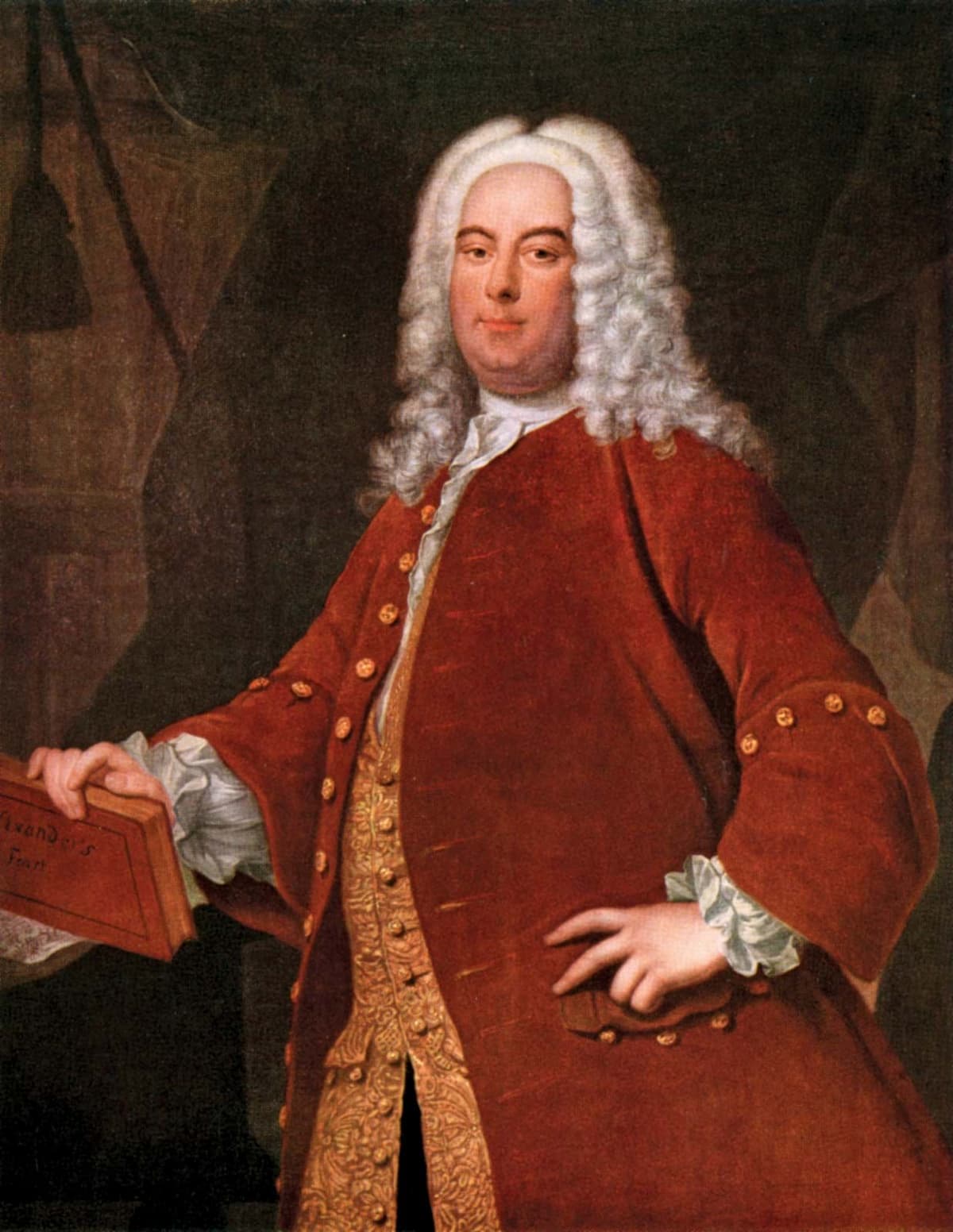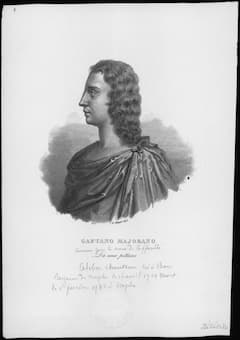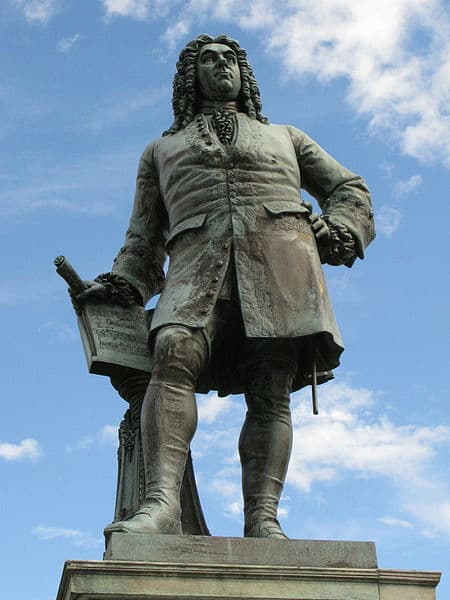Composer George Frederic Handel was born in 1685 in Halle, Germany. Over the course of his career, he became one of the most famous and influential composers of the Baroque Era.
Here are a few points about Handel’s life and music:

Georg Frideric Handel
- Handel had an international career. We don’t know a lot about his early life, but we do know that as a young man, he worked as a church organist in Hamburg. In 1706 he began living, traveling, and working in Italy. By 1712 he decided to settle in England, where he would live for the rest of his life.
- He went through a variety of creative phases during his career, but he is probably best known today for his oratorios and operas. And yes, that includes “The Messiah” and its ubiquitous Hallelujah Chorus.
- He worked as a theater manager and impresario. He used his income from putting on performances to invest, and he made a fortune. Some modern scholars have pointed out that he benefited from the success of the South Sea Company, which profited handsomely from the Atlantic slave trade.
- He was friends with royalty. Many of his most beloved works have some link to British royalty…a family that was, at the time, also Hanoverian royalty.
Is your curiosity piqued? Read on to learn more about and listen to his music:
Rinaldo (1711)
“Rinaldo” was a historical opera set during the Crusades. It was also the first Italian language opera written for London audiences. Handel added to its Italian feel by using material he’d composed during his stay in Italy.
These choices put Handel, a German man, in the middle of a conversation about the suitability of Italian music being staged in an English-speaking country. These geographically diverse influences became a defining hallmark of his work again and again.
Not all critics were convinced by “Rinaldo”, but audiences loved it. It ended up being the most popular Handel opera of his lifetime.
The aria “Lascia ch’io pianga” (or “Let Me Weep”) is a plea by the daughter of a leader of the Crusader army to her captor, and it is often performed separately from the opera.
Water Music (1711)
In the summer of 1717, King George I threw a legendary concert.
On the evening of July 17, he boarded a royal barge with other aristocrats for an excursion up the Thames.
As they sailed along, a second barge filled with musicians played Handel’s Water Music.
The king was so pleased with the work that the musicians repeated it for over four hours, late into the night.
The spectacle drew listeners from across London, who all flocked to the Thames to witness the aquatic processional. It wouldn’t be the first time that Handel’s music would pay tribute to the glory of the monarchy.
Alcina (1735)
Handel acquired the libretto – i.e., the words and story – of the opera “Alcina” when he was working in Italy.
However, he didn’t put it to music until 1735, when he needed material for his first season writing operas for the Theatre Royal at Covent Garden, a new London venue.
One interesting aspect of “Alcina” – and Handel’s work more generally – is that he worked on it with collaborators. In this case, one was pioneering dancer Marie Sallé, who he wrote dance music for in the score. The year before, in 1734, she had choreographed a version of “Pygmalion”, becoming the first woman to choreograph a ballet for the public and also to dance in it.
Handel also worked with the leading sopranos of his day. The aria above is sung by a sorceress character in love with a heroic knight. The singer who first played that sorceress was a soprano named Anna Maria Strada. She worked with Handel on twenty-four of his operas.
“Alcina” reminds us that it’s important to celebrate the many dazzlingly talented colleagues that made Handel’s creative vision possible.
Funeral Anthem for Queen Caroline (1737)
George I (he of Water Music fame) had a daughter-in-law named Caroline of Ansbach.
For many years, George I had a strained relationship with Caroline and her husband, but they eventually reconciled.
She died in 1737 a deeply beloved figure. Voltaire wrote of her, “I must say that despite all her titles and crowns, this princess was born to encourage the arts and the well-being of mankind.”
She had been Handel’s friend and patron for over three decades. He only had a few days to write her funeral music. It must have been a tough job.
The music he came up with is grave and solemn, featuring texts from the Biblical books of Lamentations and Job.
The results are deeply moving. In fact, writer and historian Charles Burney called this the greatest of all Handel’s compositions.
This work later served as an inspiration for Mozart’s Requiem.
Ombra mai fu from Serse (1738)
This aria – “Never was a shade” – from the opera “Serse” has become one of the most famous of Handel’s works. It’s particularly popular at weddings and funerals.

Caffarelli, castrato singer, the first Serse
It features a character singing to a lovely plane tree, “Never was a shade / of any plant / dearer and more lovely, / or more sweet.”
Handel wrote several dozen operas, and not all of them were successes. In fact, the opera “Serse” was an outright failure. But this specific aria was rediscovered in the Victorian era, and it has been popular ever since.
12 Concerto Grossi op.6 (1739)
A concerto grosso is a type of Baroque music that features soloists playing to the accompaniment of a larger group of musicians.
The form was in flux during the eighteenth century, and different composers wrote different kinds of concerto grossi.
Handel initially programmed these as breaks in vocal-heavy oratorio performances. It was a solid business decision: watching the performance of virtuosic instrumental music enhanced the concert experience for patrons, and hopefully would keep them from attending rival presenters’ concerts.
The pressures of the music business, combined with deteriorating health, led Handel to have a breakdown at the end of the 1737 season. Luckily, he recovered.
However, afterward, he chose to stop presenting Italian opera and focus on composing English language oratorio instead.
This shift in focus meant there were more opportunities than ever to perform these concerto grossi. Twelve of them were published in London in 1739.
Organ Concertos Op. 4 (1740)
With his concerti grossi, Handel had hit upon a winning formula: instrumental works for breaks in oratorio performances. His audience clamored for more.
He continued in this vein by writing organ concerti, which not only showcased his compositional abilities, but his keyboard virtuosity, too.
These organ concerti were innovative; at the time, it was rare to hear the organ outside of a sacred context. Audiences raved.
The Messiah (1741)
This is undoubtedly the most popular work that Handel ever wrote. If you know the Hallelujah Chorus, you know a part of “The Messiah.”
In July 1741, a collaborator named Charles Jennens sent Handel a libretto (basically, the script) for a new work for orchestra, soloists, and choir called “The Messiah.”
Jennens wrote to a friend, “I hope [Handel] will lay out his whole Genius & Skill upon it, that the Composition may excell all his former Compositions, as the Subject excells every other subject.”
Jennens’s hopes were borne out. Handel was deeply inspired by his words. He began composing on 22 August and finished on 14 September. Amusingly, Jennens was offended by how fast Handel had composed it, fearing that he had done a rush job!
“The Messiah” was premiered at an April 1742 charity concert in Dublin. In June, Handel mounted another performance there – this one for his own financial benefit.
“The Messiah” had a somewhat rocky reception back in London. Some believed that presenting a work about Christ in a theater was a bit crass. Future listeners, however, fully embraced “The Messiah”, and it remains Handel’s most famous work to this day.
“Arrival Of The Queen Of Sheba” from Solomon (1748)
Handel continued writing oratorios with Biblical subjects. In 1748, he took on the story of Solomon, the ancient King of Israel, famous for his wisdom.
The thrilling arrival of the Queen of Sheba is portrayed in this lavish instrumental interlude featuring two jaunty oboes. She brings Solomon an entire caravan of gifts, and Handel portrays the bustle and hubbub of the great delivery perfectly.
Music for the Royal Fireworks (1749)
Handel’s relationship with the royal family came into play again in 1749, when he was asked by George II to compose music for fireworks display that would mark the end of the War of Austrian Succession. (George II was the son of George I and the widower of the late Queen Caroline.)
Handel’s music offers an energizing, celebratory pomp and gusto. In the end, the music ended up coming off more successfully than the fireworks did. Those set a pavilion and a woman’s dress on fire, and also blinded a soldier.
Jephtha (1751)
The Biblical story of Jephtha is a horrific one.
Jephtha leads the Israelites in battle, and in exchange for the Lord’s help, vows to sacrifice whatever he sees and leave his door first.
To his horror, the first thing to cross the threshold is his beloved only child, a daughter.
She asks for two months’ reprieve to grieve before she meets her fate. At the end of the two months, she is sacrificed.
In Handel’s version of the story, the sacrifice is more metaphorical than literal. As his father lifts his knife, an angel comes and announces that it will satisfy God if the daughter dedicates her life to Him and never marries. Everyone lives (comparatively) happily ever after.
Conclusion

Monument of George Frideric Handel
Not long after “Jephtha”, Handel began having health troubles.
The year previous, he’d been in a bad carriage accident.
Then in 1751, he started losing his vision, thanks to a cataract. His situation worsened when a quack eye doctor named Chevalier Taylor operated on him, to no avail. By 1752, he was entirely blind.
Handel died in 1759 in his seventies. Three thousand people attended his funeral, and his music is still beloved today. In fact, his Arrival of the Queen of Sheba was played at King Charles III’s coronation in 2023.
Learn more about Handel and his music in our tag.
For more of the best in classical music, sign up for our E-Newsletter

